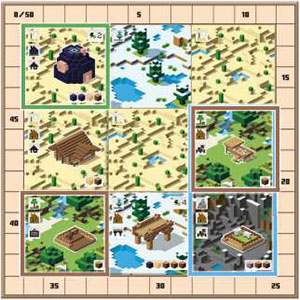

In Minecraft: Builders & Biomes, players explore the Overworld, mine blocks, and build spectacular structures. Plan your builds carefully and defeat dangerous mobs to win!
Components

- 64 resource cubes
- 64 building and Monster cards
- 36 weapon tokens
- 4 player boards
- 4 experience counters
- 4 character skins
- 4 game piece Bases
- 12 overview cards
- 1 resource cube base
- 1 support structure,
- Rulebook
Setup
1 Shuffle the 64 building and mob tiles and divide them into 16 face-down stacks of four tiles each. Lay them out in a 4 by 4 grid, with enough space between the rows for your game pieces to move between them.
2 "Shuffle the 16 colorless weapon tokens and place one, face down, at the ends of each column and row to form a six by six grid. (Leave the corners empty)."
3 Place the block base next to the grid in easy reach of all players. Assemble the support structure and place it on the block base. Fill it with the 64 blocks (16 wood, 14 sand, 12 stone, 10 obsidian, and 12 emerald) in random order. Gently shake until the blocks form a big cube. Then remove the support structure by lifting it up on its flaps.
4 Each player chooses a color (red, blue, yellow, or green) and takes the player board and game materials of the same color. Game materials include one game piece base, one experience counter, and five colored weapon tokens (one stone sword, one wooden sword, and three poisonous potatoes).
aPlace your experience counter on space 0 of the experience point track that runs along the edge of your player board.bShuffle your 5 weapon tokens and put them in a face-down pile.cChoose a player skin (character appearance) and push it into your game piece base. This is your character. Place it on the central crossing of the card grid.
Hint: You can customize your characters by painting the 4 blank skins, or by putting your own stickers!
5 Place one set of the overview cards (Turn Actions, Scoring A, Scoring B, Scoring C) between players 1 and 2 and the other set between players 3 and 4.

Game Play
The player who most recently found a diamond in Minecraft is the starting player. When in doubt, the youngest player begins.
During your turn you must choose and perform two different actions. You cannot perform the same action twice. Once you have taken your actions, play proceeds to the left.
During the game there are three scoring rounds. The player with the most experience points after the third scoring round is the winner.
Actions
Collect Blocks
Take two blocks from the big cube. Blocks (materials) can only be collected if their top side plus at least 2 more sides are exposed.
As long as these conditions are met, you are free to choose any block from any layer, and from any side of the big cube. Add the blocks to your personal supply next to your player board.
Notes:
The green emerald blocks are wildcards. Use them instead of other blocks when building a structure (see below).
Feel free to rotate the block base. This allows you to look at the big cube from all sides and find the blocks you need for your structures.
Explore the Overworld
First, move your character zero, one, or two spaces. "Spaces" are the crossing points in the grid of card stacks and weapon tokens. Never place your character on a card or token.
Next, reveal the top cards of the four corner stacks around your position. If some of them have already been turned face up, leave them revealed.
Notes:
The same crossing can be occupied by multiple characters.
During the course of the game, card stacks might be fully depleted or weapon tokens collected. You still move your character along the path between stacks, even if those stacks are empty.
Build
To build a structure, your character must be next to the corresponding building card on the grid. The blocks needed to build a structure are shown in the bottom right corner of the card.
You must possess the necessary materials to build that structure. Return the blocks from your personal supply to the game box.
A green emerald block can be used to replace any other block. Take the building card from the grid and place it on any space on your player board.
Some structures need a lot of blocks, and have this icon in the top right corner of the card:  Whenever you build such a structure you immediately gain that many experience points. Move your experience counter that many spaces on your experience point track.
Whenever you build such a structure you immediately gain that many experience points. Move your experience counter that many spaces on your experience point track.
Notes:
Buildings can be built in any biome (= environment type). For example, you don't have to place a forest building on a forest space.
On the contrary, to gain more experience points during scoring, you may want to place a structure next to spaces and/or cards that share a characteristic (e.g. the same biome). More information can be found in the section "Scoring" below.You may build over existing structures. Simply place the new structure over a building card you no longer need.
Fight a Nob
Not every card in the grid is a building - some of them are dangerous mobs (monsters)! If your character is next to a revealed mob card, you can attempt to defeat it.
To fight a mob, shuffle your face-down pile of weapon tokens and reveal 3 tokens. Count the number of revealed hearts and compare the sum to the number of hearts on the mob card. Poisonous potatoes have no hearts and count as blanks.
If you revealed at least as many hearts as shown on the mob card, you defeat the mob. Remove the mob card from the grid and place it next to your player board. You immediately gain the number of experience points printed next to the
 .
.If you revealed a lower number of hearts, the mob stays where it is.
After the fight, shuffle your revealed weapon tokens back into your pile. You get to keep them. Put defeated mobs face-down next to your player board.
There are two kinds of mobs:
-

A mob card with this icon can be traded in to gain 1 additional action during one of your turns. To do this, when it's your turn, execute your 2 different
actions as usual. Then return as many mob cards with this icon as you like from your personal supply back into the game box. For each returned mob card, you may execute an additional action of your choice this turn.
As opposed to a normal turn, you are permitted to execute an action that you have already executed earlier in the same turn.
-

Mob cards with these kind of icons are kept until the end of the game, when they will gain you additional experience points for all spaces with matching characteristics on your player board.
For example, the mob with these icons will gain you 2 experience points for each forest. More information can be found in the section "Scoring" below.
Collect a Weapon
To collect a weapon token, your character must be next to it. Shuffle it into your pile of weapon tokens.
Note: You may look at your weapon tokens at any time, such as when checking to see if you have a chance of vanquishing a mob. Make sure to shuffle your pile after looking at the tokens.
Weapons with special abilities:
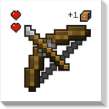
Bow: During a fight, whenever you reveal a bow, you may immediately reveal 1 additional weapon token. If you own more than one bow, you have a chance to reveal 4, 5, or even 6 tokens during a fight!
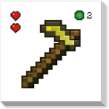
Golden hoe: During a fight, whenever you reveal a golden hoe, you immediately gain 2 experience points.
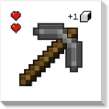
Stone pickaxe: During a fight, whenever you reveal a stone pickaxe, you may immediately collect 1 block from the big cube. You still have to follow the rules for "collecting blocks" (see action 1 above).
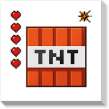
Tnt: During a fight, after revealing your weapons, if you revealed a TNT token, you can choose to detonate it. If you do, count the 5 hearts on the TNT. Detonated TNT is removed from the game (put it back into the box). Otherwise, ignore the hearts. You get to keep the TNT.
Scoring
When does the scoring happen?
-
The first scoring round (A: Biomes) happens when any player completely mines the first layer of blocks of the big cube. It doesn't matter if any blocks from deeper layers have been collected.
After collecting the final block of the first layer, that player completes their turn as usual. Scoring starts after they have finished executing their actions.
-
The second scoring round (B: Materials) happens when any player completely mines the second layer of blocks of the big cube.
-
The third scoring round (C: Type) happens when any player completely mines the third layer of blocks of the big cube. Then the game ends, even if there are still blocks left in the bottom layer of the big cube.
Notes:
If you own any mob cards that grant you additional actions, feel free to use them in the same turn in which you triggered a scoring round.
Scoring starts only after you have executed all your actions and finished your turn.
It is possible to deplete multiple layers during the same turn, by collecting multiple blocks (e.g. by revealing the stone pickaxe during a mob fight, or by trading in a mob card for an additional action).
In that case, after finishing your turn, all triggered scoring rounds happen one by one in the usual order (A B C).
How does scoring work?
The player who just finished their turn goes first. Choose exactly one out of the four characteristics on the current scoring card to gain experience points in that characteristic.
-
In the first scoring round (A: Biomes), you choose exactly one biome: forest, desert, mountains, or snowy tundra.
On your player board, identify the largest group of connected spaces that share this characteristic. For each space in this group, you gain the number of experience points printed next to that characteristic on the scoring card.
Notes:
Diagonal spaces do not count as connected.
For the first scoring round (A: Biomes), in addition to the biomes on your building cards, also count biomes printed on your player board (if visible).
You may also choose a single-space group. For example, you could gain 6 experience points for a single snowy tundra space on your player board.
Each building card lists its characteristics as icons in its left margin: The top icon shows the biome (scoring A), followed by material in the middle (scoring B) and type on the bottom (scoring C).
Scoring round A example: You choose desert, since that forms the largest biome on your player board. It consists of 4 spaces.
The desert in the top right corner of your player board is diagonally adjacent to the rest of your desert spaces. It doesn't count as part of the continuous group.
For each space, you gain 4 experience points (see scoring card). In total, you gain 4 x 4 = 16 experience points.
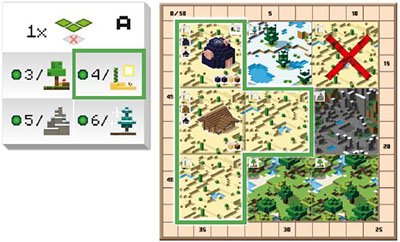
When you're done calculating your experience points, add them to your existing points on the experience point track on your player board by moving your experience counter that many spaces forward.
Then the next player in turn order scores a biome of their choice. Once every player has scored, return the scoring card to the box. For the next scoring, you will need the next scoring card (B: Materials).
After scoring, continue playing in turn order. The player sitting next to the one who triggered the scoring goes next.
Note: During scoring, do not remove any structures you built, or the blocks in your supply. You get to keep them! Start planning for the next scoring round, and build structures accordingly!
-
For the second scoring round (B: Materials) you either choose wood, sand, stone, or obsidian. You score the biggest continuous group of structures matching that material (see the middle icon on the building cards). The biomes no longer matter, ignore them.
Scoring round B example: You choose wood, since the wooden structures form the largest continuous group on your player board. It consists of 5 spaces.
For each space, you gain 3 experience points (see scoring card). In total, you gain 5x3= 15 experience points.
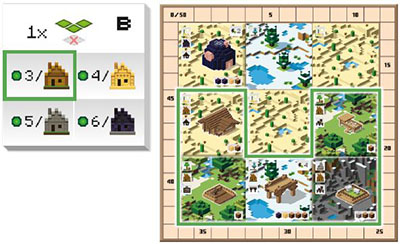
-
The third scoring (C: Type) follows the same rules. Select the largest continuous group of structures of a particular type: decoration, dwelling, animal house, or bridge.
Scoring round C example:
The third scoring round happened so fast that you didn't have a chance to build more structures.
Your biggest groups are two dwellings or two animal houses. The animal houses are more valuable (see scoring card), so you select that group and gain 2x5 = 10 experience points.

End of the Game
The game ends after the third scoring round. Now, it's time to score each mob in your collection with icons of the following type: 
You gain that many experience points for each space on your player board with that characteristic.
Important: As opposed to the scoring rounds A, B, and C, the mob cards count all spaces of that characteristic. The spaces don't have to be connected.
After each player has scored their mobs, compare your experience points. The player with the most experience points is the winner. If there is a tie, the player with the most blocks in their supply wins the game. If there is still a tie, the tied players all win.
Mob scoring example:
During the game you defeated the following 4 mobs:
You gain 2 experience points for each forest, for a total of 4.
You gain 3 experience points for your 1 obsidian structure, a total of 3.
You gain 3 experience points for your 2 animal houses, a total of 6.
You gain no experience points because you don't have a sand structure.
In total, you gain 4 + 3 + 6 = 13 additional experience points at the end of the game.
Variant for beginners
If you are playing for the first time, or with kids, there is a great way to simplify the three scoring rounds: Instead of counting the largest continuous group, just count all spaces matching that criteria on your player board.
That means less planning ahead, since you can place the building cards on any space of your player board.
Hint: This variant can be combined with the normal game. For example, allow kids to score by the simplified rules while grown- ups score by the normal rules.
Continue Reading
